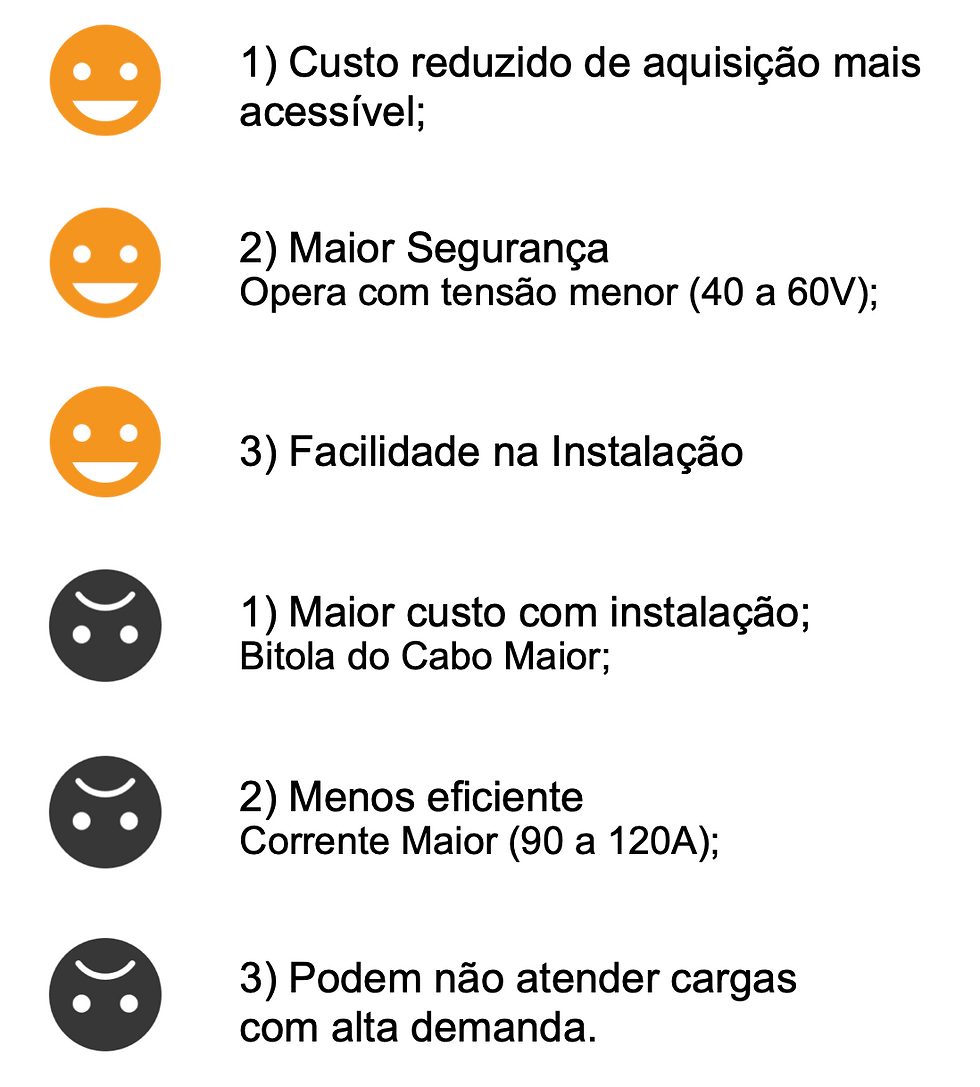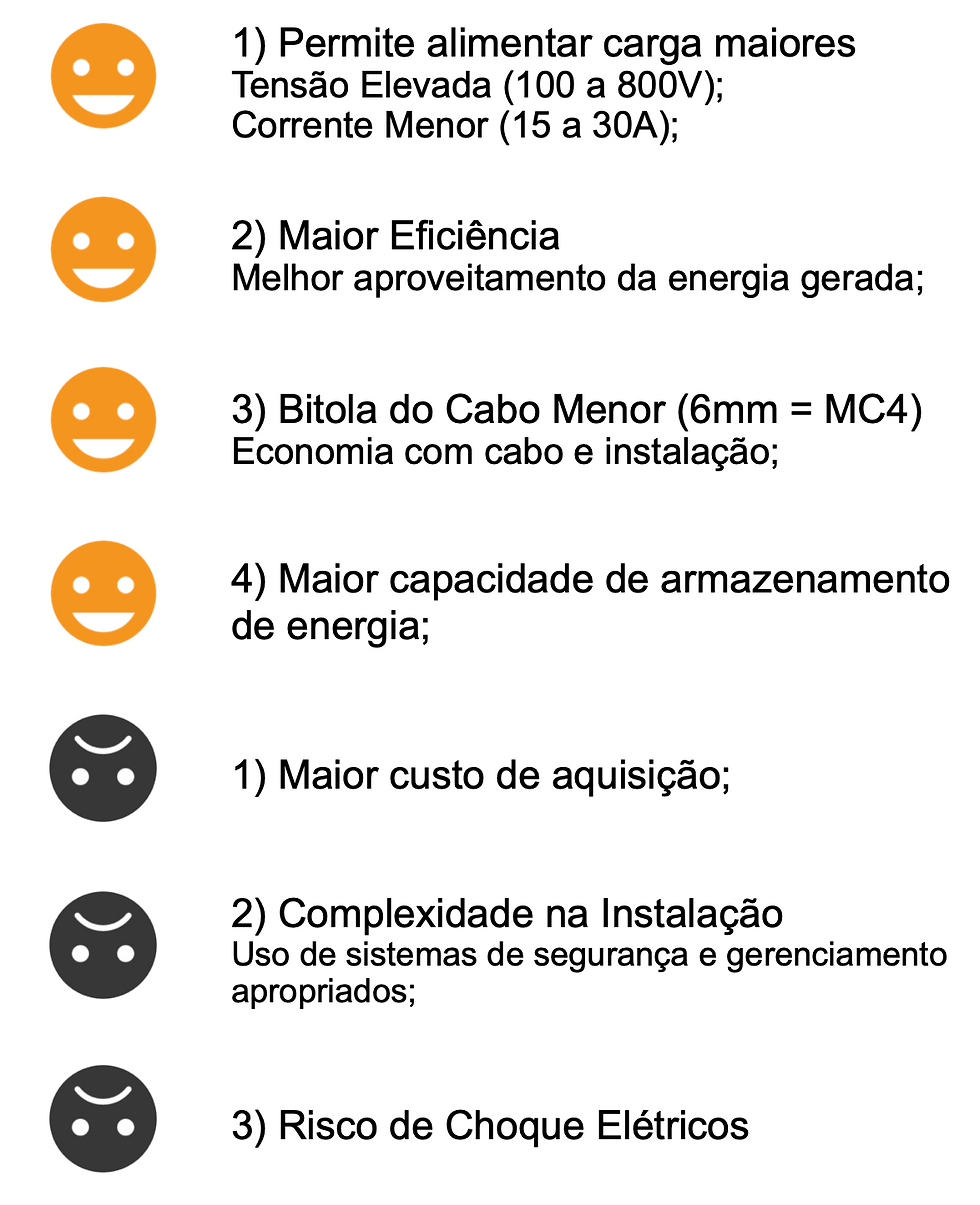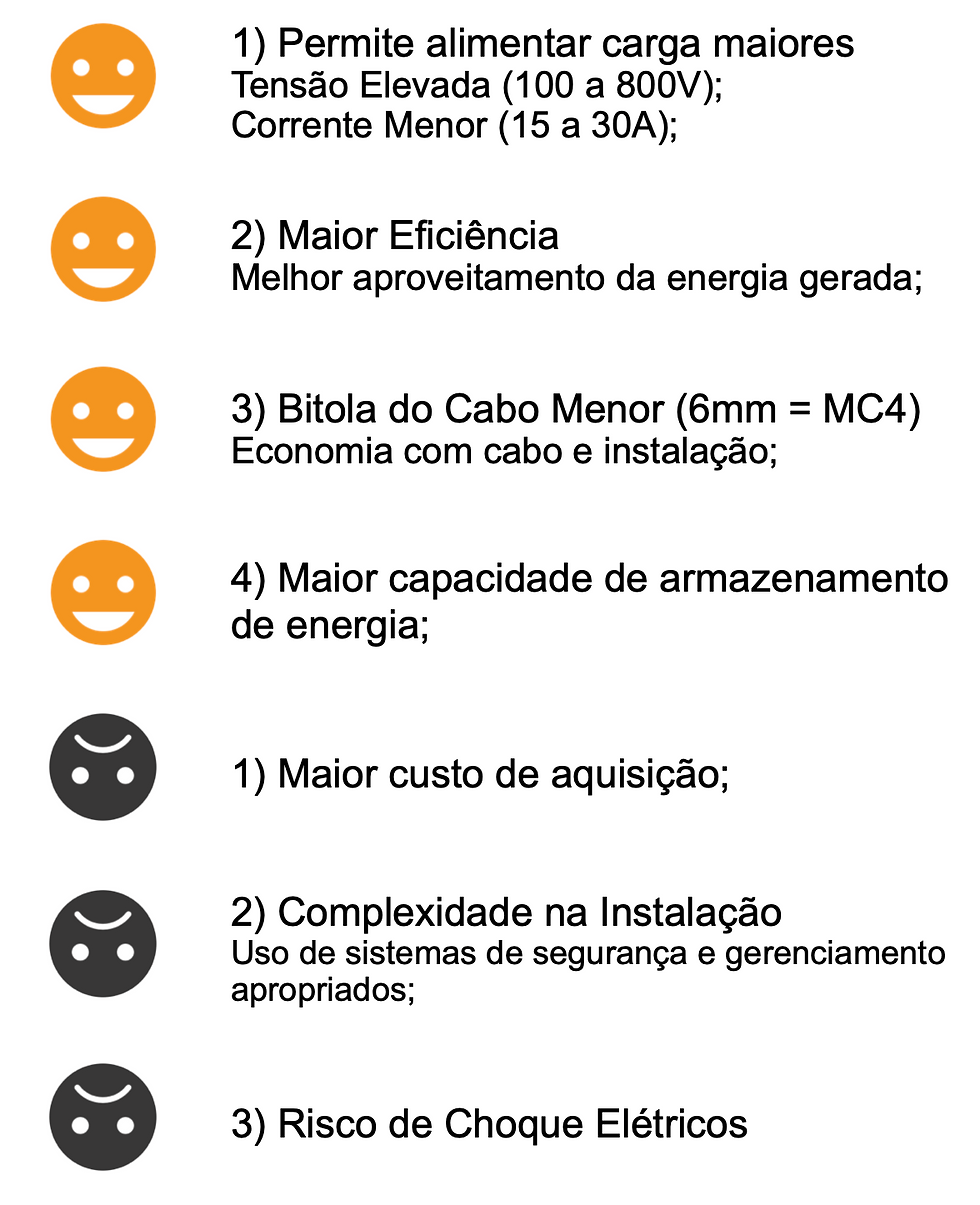Hybrid Systems, in which situations should I install high voltage and low voltage batteries?
- Nansen Solar

- Aug 15, 2024
- 9 min read
By Youssef Barreiros - Pre-Sales - Nansen Solar

When planning to install a solar power system, it is essential to carefully analyze the battery options available on the market, giving preference to reputable manufacturers known for their exceptional quality and superior performance. Choosing the appropriate battery type will always depend on the unique needs of each consumer. Typically, these batteries come with a 10-year warranty and feature a depth of discharge of up to 90%. Although solar panels are most commonly associated with photovoltaic energy, in what situations is it more appropriate to install high-voltage or low-voltage batteries? Since the solar energy market offers a wide variety of battery options to suit all types of photovoltaic projects, be it residential, commercial or even solar power plants. Thus, the main purpose of this article is to understand under what circumstances it is appropriate to install high-voltage and low-voltage batteries. Thus, solar batteries are used in photovoltaic systems to allow users to disconnect from the electrical grid, ensuring stability in the power supply. In other words, these devices are designed to store energy, providing greater autonomy or even total independence from the power grid, eliminating concerns about power outages or rising bills. Although they are becoming more affordable, solar batteries require a considerable investment and there are few options on the Brazilian market.
Keywords: Solar Batteries. High and Low Voltage System. Electric Field.
1. INTRODUCTION
There are two main types of solar batteries: high voltage (HV) and low voltage (LV). These systems allow energy to be stored for use after sunset, as well as allowing energy to be purchased from the grid when the cost per kWh is lower. But after all, which is the best battery option? The distinctions between HV and LV batteries help the consumer make a decision.
The solar battery market, although it has been around for many years, gained significant traction in 2015 with the introduction of Tesla's energy storage system, the Powerwall.
This groundbreaking announcement was followed by other major battery manufacturers such as LG, Samsung and BYD, who quickly jumped on the bandwagon, offering batteries with comparable pricing, performance and warranty.
The subsequent launch of the Powerwall in 2016 further solidified the solar battery revolution.
By reducing the impact of high taxes and fees on electricity bills in Brazil, such as TUSD, TUST, tariff flags, lighting tax, ICMS, PIS and COFINS, solar energy batteries increase the reliability of energy supply. They allow consumers to benefit from solar energy continuously, 24 hours a day.
There are considerable benefits associated with implementing a backup system, not only does it decrease reliance on the traditional power grid, it also results in significant savings on electricity bills.
Solar power backup provides autonomy, ensuring a continuous supply of energy even during grid outages, while promoting environmental sustainability by avoiding the need for non-renewable resources.
However, it is essential to take into account the initial investment required for the acquisition and installation of storage batteries, as well as their long-term maintenance.
The growing demand for clean energy sources and the search for savings on electricity bills are driving the adoption of solar energy.
2. How does a solar battery work?
The purpose of a battery in a solar-powered system is to store the electricity generated by the solar panels and have a reserve that can be used when needed. In simple terms, a battery is made up of electrochemical components that function as electrical reservoirs or accumulators, which means that it is a device that stores energy through chemical reactions.
To discharge its energy, batteries have plates that are positive (cathode) and negative (anode), these plates cause ions to move between them. This phenomenon is common when the battery is charging or discharging.
Following this mechanism, batteries can be made from different substances and used for different purposes. Some types of batteries are designed for use with solar energy, especially those made from lead-acid or lithium ions.
Batteries play a fundamental role in two types of solar energy systems: Off Grid and Hybrid.
In the Off Grid system, the energy stored in the batteries is used to meet demand when solar generation is not sufficient, such as at night or on cloudy days. This ensures a constant supply of energy throughout the day, regardless of weather conditions.
In hybrid systems (“On+Off Grid”), solar batteries play an essential role as a complement. In addition to supporting solar generation during periods of low radiation or absence of sunlight, they are essential for maintaining the continuity of the electricity supply in the event of failures in the public grid. This not only increases the reliability of the system but also provides greater autonomy to consumers, allowing the continued use of renewable energy even in adverse situations.
For each installed battery, it is necessary to have a driver that controls the charge and release of energy, ensuring that the battery does not overcharge and operates safely. In the case of lithium batteries, there is a system called BMS (Battery Management System), which controls the charge and discharge of the battery. The BMS ensures that the battery operates healthily and efficiently, preventing damage and extending the life of the equipment.
3. Off-Grid Systems
In an off-grid solar power system, your property operates independently of the grid, meaning that all of your electricity is generated by solar panels and stored in batteries for use at night. The advantage of this setup is that your property becomes a self-sufficient “island” without the need for meters or electricity bills.
However, it’s important to note that completely off-grid setups can be quite expensive, with the cost being a factor.
But it’s worth mentioning that many off-grid solar homeowners reside in remote areas where a diesel generator may be the only alternative.
4. Hybrid Solar Energy System
Hybrid photovoltaic systems are designed to connect the property to the electricity grid and store solar energy in batteries. These systems prefer to use the electricity stored in their batteries instead of electricity from the grid.
A notable advantage of hybrid systems is their cost-effectiveness compared to off-grid solar generators, as they require fewer batteries to store solar energy. It is possible to program the system to use the stored energy during the distributor's peak hours (tariff compensation) and guarantee several hours of autonomy in the event of problems in the electricity grid.
It is worth noting that Nansen Solar inverters can operate in four different modes:
On-grid system: Without batteries, connected to the photovoltaic (PV) system and the power grid. If the consumer chooses not to buy batteries, the energy generated by the solar panels is used directly and the surplus is sent to the grid.
Off-grid system: Without connection to the power grid, only connected to the photovoltaic (PV) system and batteries. Ideal for consumers in remote locations or without access to the power grid. All the energy needed is generated and stored locally.
Hybrid System: Complete version, with all connections made (PV, batteries and power grid). The consumer benefits from all energy sources, with greater stability and energy security. Allows the use of solar energy, battery storage and connection to the power grid as a backup.
No-break or Compensation System: Without connection to the photovoltaic (PV) system, the inverter of this system charges the batteries from the power grid during periods of lower tariffs. The stored energy is then used at times of peak consumption, allowing the consumer to reduce energy costs through tariff compensation. In addition, the system can be used as a backup during power grid failures, ensuring a reliable power source.
FIGURE 02 – Images from the Nansen Solar Monitoring App
Nansen Solar models can be programmed according to the user's needs. One example is the priority of using the generated energy, which can be defined in the system monitoring. The user can define the priority for the unit, the battery or export to the electrical grid.
5. Which battery should I use for my solar panel?
There are two main categories of solar batteries: high voltage (HV) and low voltage (LV). These energy storage systems allow you to store excess energy generated for use at night or to purchase energy from the grid at lower prices for storage.
But after all, which type of battery is the most suitable? Voltage is the measure of the difference in electrical charge between two points. It indicates how much energy is available to make electricity flow. The magnitude of this difference shows how strong the "push" is for the electricity to move.
Higher voltages make it easier for electricity to flow to electronic devices. However, many devices are designed to operate at specific voltage levels. Too much voltage can damage circuits, while too little voltage can compromise performance.
For solar power systems, lithium-ion batteries are the most recommended. They offer several advantages, such as higher efficiency, longer lifespan, and better storage capacity compared to other types of batteries.
Therefore, it is crucial to choose a lithium-ion battery with the appropriate voltage to ensure the safe and efficient operation of the devices in your solar power system.
6. Low-voltage battery
Low-voltage batteries are designed for a voltage below the 100V limit. These batteries discharge energy relatively slowly, which can lead to challenges in meeting start-up loads. In such cases, additional grid or solar power support may be required to ensure immediate power supply. These batteries operate at lower voltage levels, typically in the 12-48V range.
It is worth noting that the cost-benefit of low-voltage batteries is significant, as they are generally cheaper and installation is simpler. However, the cost of cabling is higher, as the gauge must support the high current.
FIGURE 03 – Low voltage

Low-voltage lithium batteries are popular in small residential solar systems, recreational vehicles, portable power systems, solar garden lighting, remote telecommunications devices, and backup systems for small electronics. They are chosen for their efficiency, ease of installation, and cost-effectiveness.
7. High Voltage Battery
High voltage battery systems are typically rated at over 100V. These batteries have the ability to charge and discharge at higher rates than low voltage batteries, making them perfect for handling sudden spikes in demand when powering appliances.
Operating at higher voltage levels, typically between 200V and 600V or above, high-voltage battery systems represent a new trend in backup batteries for solar-powered homes.
High voltage models have the capacity to generate more energy to support heavier loads, making them ideal for homes with high electricity consumption, surpassing the limits of batteries with lower voltages.
It is worth noting that medium and high voltage batteries contain higher energy density and therefore require additional protections, such as improved management and safety systems. For this reason, they end up being more expensive than low voltage batteries.
FIGURE 04 – High voltage

Low-voltage lithium batteries are popular in small residential solar systems, recreational vehicles, portable power systems, solar garden lighting, remote telecommunications devices, and backup systems for small electronics. They are chosen for their efficiency, ease of installation, and cost-effectiveness.
7. High-voltage battery
High-voltage battery systems are typically rated at over 100V. These batteries have the ability to charge and discharge at higher rates than low-voltage batteries, making them ideal for handling sudden spikes in demand when powering appliances.
Operating at higher voltage levels, typically between 200V and 600V or higher, high-voltage battery systems represent a new trend in backup batteries for solar-powered homes.
High-voltage models are capable of generating more power to support heavier loads, making them ideal for homes with high electricity consumption, overcoming the limitations of lower-voltage batteries.
It is worth noting that medium and high voltage batteries contain higher energy density and therefore require additional protections, such as improved management and safety systems. For this reason, they end up being more expensive than low voltage batteries.
FIGURE 04 – High voltage

8. Battery for residential solar energy
Although solar energy storage systems are similar in some aspects, the batteries used and their functions can vary to meet different needs. Lead-acid batteries, the traditional choice for residential solar energy storage, are renowned for their reliability and pioneering nature.
However, they generally have lower storage capacity and shorter lifespans compared to other technologies. Meanwhile, lithium-ion batteries are widely adopted for their high energy density, superior efficiency and long durability.
In addition to being lighter and more compact than lead-acid batteries, they also require less maintenance.
Nansen Solar offers residential energy storage solutions with high-quality, fast-charging HV batteries. The battery packs consist of ABL-T05H-H01 lithium modules, which have a nominal power of 1.5 kWh. A total of 4 modules can be stacked, totaling 21.2 kWh, which perfectly meets the energy needs of residential use.

Since 2010, the price of lithium batteries has dropped by 89%, representing 50% of the average cost of installing a hybrid system on the market.
GRÁFICO 01- Preços das baterias
Despite the low cost of lithium batteries, this has not affected their storage capacity, i.e. their volumetric density has increased considerably by 5 times.
GRAPH 02 – Battery capacity
9. CONCLUSION
When dealing with high or medium voltage, it is crucial to implement additional safety measures. High voltage energy storage devices are now essential for household activities. These systems are designed to transform DC voltage into AC voltage, ensuring the correct operation of everyday equipment and ensuring optimal performance.
Across the world, more and more people are opting for solar energy storage systems as a solution to power outages and high utility bills. Nansen Solar emphasizes the importance of a reliable power supply.
Nansen Solar storage systems are recognized for their exceptional efficiency, providing customers with maximum energy efficiency. In addition, the systems allow for self-consumption, are ideal for a variety of applications and provide backup, offering peace of mind in the event of outages. Nansen Solar stands out in the market for its technological innovation and commitment to sustainability, ensuring high-quality products and reliable performance.

















Comments